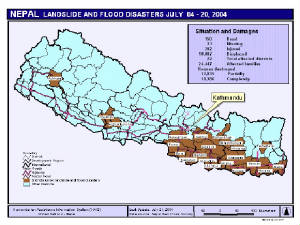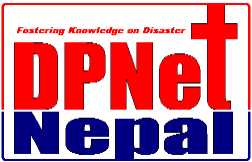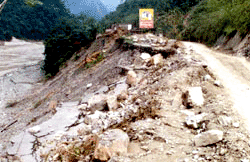7th Earthquake Safety Day - 2005
We
are observing 7th Earthquake Safety Day on January
15, 2005. For your kind
information few activities are listed below. If you are interested to participate, please kindly contact NSET for details.
Program details:
7 January 2005
Time:
9: 00
- 17:00
Symposium
on Earthquake Risk Management in Nepal
Venue:
Russian Culture Center, Kamal Pokhari
10 January 2005
Time:
10:
30 - 15:00
On
the Spot School Children Art Competition
Participants:
Class VI to X from Schools of Kathmandu Valley.
Venue:
Patan Durbar
Square,
Kathmandu
14-17 January 2005
Time:10:00 - 17:00
Earthquake Safety Exhibition
Venue:
Patan Durbar
Square,
Lalitpur
(Main
highlights will be exhibition stalls exhibiting disaster management
activities by national and international agencies,
Shake Table
Demonstration of buildings with and without earthquake resistant elements;
in-situ exhibition of full-scale
construction details of prevalent building;
photo exhibition; children art exhibition).
NSET receives 'Tech Museum Award'
National Society for Earthquake Technology (NSET), Nepal --
a non-governmental organisation-- has been awarded with this year's 'Tech Museum award' under the `Microsoft Education Award'
category for its low-tech innovation called 'Shake Table' to reduce hazards from earthquake.
According to NSET, executive director of NSET Amod Mani Dixit
received the award amidst a ceremony organised at San Jose, Silicon Valley, California on Thursday.
"Selection as the Laureate of Tech Museum Award is a witness
of the success of the efforts of NSET in implementing earthquake risk reduction initiatives in Nepal, and recognition of our
efforts in bringing in the fruits of science and technology to the doorsteps of the common man so thathe/she could use it
for reducing the ever-increasing vulnerabilities to natural hazards," said Dixit, upon receiving the award. "He said it was
a moment for pride for NSET as well as Nepal."
National Society for Earthquake Technology - Nepal (NSET)
has been selected as a Laureate for the Tech Museum Awards 2004. The Tech Museum Awards honor innovators and visionaries from
around the world who are applying technology to profoundly improve the human condition in the categories of education, equality,
environment, health, and economic
development.
"The Tech Awards laureates are pioneering appropriate technology
solutions to aid so many people, but it's the ease with which their innovations can be scaled and replicated elsewhere that
will continue to truly make this world a better place," said Tech Museum President and CEO Peter Giles.
This year, more than 580 nominations were received, representing
80 countries. NSET was selected for "Best of the Best" category for technology innovation. Inaugurated in 2001, judges for
the five categories of the Tech Museum Award are recruited from research institutions, industry and the public sector around
the world.
According to NSET, the 'Shake Table' technology has already
been demonstrated in Iran, India,
Tajikistan, Afghanistan
and Japan over the last six years. The technology
will now be demonstrated at the Tech Museum in the USA,
the statement said.
Statistical- Disaster Situation Report
Covering period: - 4
July to 25 July, 2004
According to the reports received from NRCS District Chapters & Ministry of Home
Affaires (MOHA), and different medias, in Nepal, the recent floods and landslides
have affected the lives of approximately 360,243 persons of 62,357families in
25 districts of the kingdom.
HMG MOHA, Nepal Red Cross Society and larger civil societies are mobilized and has been providing relief materials to the affected people in coordination with other authorities and data
are being collected.
Affected Districts are: Jhapa,Morang, Sunsari, Saptari, Siraha, Dhanusha,
Mahottari, Sindhuli, Sarlahi, Rauthat, Bara, Parsa of east Terai in Nepal and similarly, Arghakhanchi, Palpa, Dhading, Makawanpur,
Ramechhap, Kabhre, Udayapur, Khotang, Okhaldhunga, Terhathum, Kabhre in East Hills and Pyuthan, Achham west hills in Nepal.
|
Nepal Disaster Situation Summary
As of July 25 2004 |
|
No. of district affected |
25 |
|
No. of VDCs affected |
450 VDC and
8 Municipalities |
|
Total population affected |
0.4 million |
|
Total area affected |
na |
|
Total crop area affected |
na |
|
Loss of lives |
173 (as on 25/7/2004)
|
|
Seriously Injured population |
305 |
|
People Missing |
35 |
|
Families Displaced /
Families
Affected |
28,555 and
62,357 HHs |
|
Loss of livestock |
na |
|
Houses damaged |
15,563 fully and 345,563 partially |
|
Physical infrastructure affected (road, tube well, ponds, embankments etc.) |
Major
bridge, highway, Limited data available |
|
Loss due to the flood |
50 Crores |
|
Relief Camps |
DNDRC at District level, NRCS, I/NGOs, Civil Society Organization and local units of political
parties have run at local level |
|
Source: NRCS and News Media |
| Nepal Flood Scenario 2004 |

|
| Source: HAIS, UN Nepal |

Preliminary Recommendations of the
National Workshop on Pre-monsoon Disaster Preparedness
June 27, 2003 Kathmandu
A one
day workshop on Pre-monsoon Disaster Preparedness was held by Nepal Center for Disaster Management (NCDM) in collaboration
with the His Majesty's Government, Ministry of Home Affairs, UNDP, Action Aid Nepal, Lutheran World Federation and United
Mission to Nepal on 27th June, 2003 in the Park Hotel and Resort, Budhanilkantha, Kathmandu. The NCDM is a non-governmental
organization (NGO) committed towards working for the cause of disaster management in the country. The Workshop was inaugurated
by Mr. Tika Dutta Niraula, the Secretary of the Ministry of Home Affairs. In an inaugural function chaired by the President
of NCDM, Mr. Dipendra Purush Dhakal and conducted by its General Secretary Prof. Dr. Bishal Nath Uprety the welcome address
was delivered by its Vice President, Professor Dr. Jiba Raj Pokharel. The workshop was attended by 78 participants representing
42 organizations and institutions including government offices and its line agencies, the international and national non-governmental
organizations, the diplomatic and donor communities, academia, media and affected communities from the earlier disasters.
The
Workshop had twin objectives of identifying the gaps and at times even gulfs that exist between the plan and performance in
the disaster management in Nepal and then to find ways and means by which these lacuna can be narrowed down or bridged to
the extent possible.
In the
second session of the Workshop, seven papers were presented covering wide spectrum of disaster related issues. The presentations
were followed by questions and answers. People directly affected by the post-monsoon disaster from Matatirtha, Chitwan and
Khotang also described about the aftermath of disasters.
The
third session was devoted to three separate group discussions. The themes addressed in the groups were Logistics; Food &
Agriculture and Health. The paper presenters and other experts facilitated the group discussions.
In the
fourth session, the groups presented their conclusions focusing on the steps that should be taken in order to have a proper
response, rescue and recovery activity.
Among
other major recommendations, the workshop had suggested with utmost priority to recommend the following actions to be immediately
implemented:
1.0.
The HMG/ Ministry of Home Affairs (MHA) should immediately
send directives to all Chief District Officers (CDOs) to hold meetings with the district and village level line agencies,
District Development Committees (DDCs)/ Village Development Committees (VDCs)/ Municipalities and other locally active non-governmental
groups for assessing the strength and weaknesses in the preparedness for the natural disaster that may cause during the monsoon
season. The meeting should concentrate on:
a.
Taking stock of the available facilities including food, shelter
and emergency health services.
b.
Mode of obtaining needed facilities in the time of disaster
c.
Repair and maintenance of the vehicles and equipments necessary
to be deployed during the disasters
d.
Making Army and the Police alert with the situation.
e.
Keeping all communication systems, including those with the
security officials, readily available in the time of the disaster
f.
Coordinating with the local bodies including authorities of
the Municipalities/ DDC /VDC and locally active support groups.
The
MHA should follow-up this matter with urgency to ensure that such meetings were conducted and aforementioned subjects were
also fully assessed. While doing it, the Ministry should prioritize the districts having the higher risk of the monsoon disasters
such as flood and landslides. The CDOs should be instructed to report regularly to the Ministry on the above.
2.0.
The Municipality/ DDC/ VDC authorities should hold meetings,
as many times as necessary, participated by at least one of the member of the household, to discuss on the following subjects:
a.
Creation of a Local
Disaster Committee (LDC) chaired by the Municipality or the VDC authority
b.
Availability of the first aid facilities locally
c.
Establishment of a Local Disaster Fund (LDF), similar to the
earlier concept of Dharmabhakari, through the contributions in cash or kind by the local households
d.
Likelihood of the occurrence of the flood or the landslide
in view of the past experiences
e.
Possible victims in the wake of the flood or the landslide
f.
Places for displacement of the victims in the schools, office
buildings, somebody's residence or the temporary shelters in the open areas
g.
Provision of food and clothing
h.
Prompt and most effective means of communication at the time
of disaster
i.
Holding regular meetings of the LDC
The
CDO should make follow-ups on whether or not the meeting has taken place deliberating on the aspects mentioned above. The
LDC should be instructed to inform the CDO regularly on this aspect.
Commending
the performances of the Department of Narcotics Control and Disaster Management (DNCDM), especially in the areas of search,
rescue and relief the Workshop recommended having its role further strengthened to support the initiatives of all stakeholders
in the activities related with preparedness for the natural calamities. It was the unanimous observation of the meeting that
the DNCDM could be the most capable organization toin harnessing effective coordination among different governmental or non
governmental agencies involved in disaster management at the national level. Thus, the meeting wished the DNCDM to become
more proactive and demonstrate the role of an efficient facilitator in streamlining the implementation of all appropriate
actions concerned with preparedness as well as post disaster management. The Workshop also concurred with the views of the
Director General of the Department to organize similar kind of meetings on a regular basis, under the auspices of the DNCDM,
to bring about necessary cooperation and coordination among the concerned stakeholders.
The Workshop also showed concern with the sluggish performances of the Sectoral Working Groups
(SWGs) established under the aegis of UNDP in 1994. Noting that some progress had been made with regard to the Health sector
the symposium has strongly recommended reactivating the role of other two SWGs, namely the Food and Agriculture & Logistics,
in preparing their individual sectoral disaster management plans as anticipated.
Statistical Disaster Situation Report
Covering period:- 10 June to 12 September, 2003
|
Current Situation (as reported by NRCS district
chapters)
Summary
- Dead
- 274
- Injured
- 345
- Missing
- 39
- Displaced
- 1,968
- Total affected districts - 58
- Affected families
- 10,237
- House destroyed:
- Partially
- 2,990
- Completely
- 1,458
§
Relief Materials from NRCS- 2,287 |
According
to the reports received from NRCS district branches and Ministry of Home Affairs, the recent floods, landslides and other
types of disaster have affected approximately 61,422 persons and 10,237 families in 58 districts of the kingdom. Nepal Red
Cross Society has provided relief materials to approximately 13,722 persons of 2,287 families in more than 58 districts. The
total cost of relief materials is estimated to be at Rs. 52,02,925.
|







